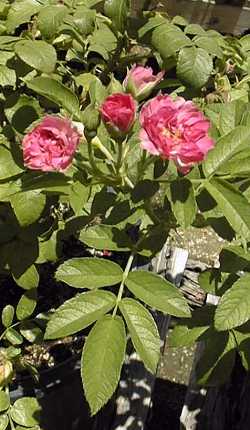Sunset®: All zones
USDA: 4-10
Sun Exposure: Full sun
Origin: Sandy seashores of northern China, Japan, Korea
Growth Habits: Shrub, up to 8 feet tall (2.5 m)
Flowers: White flowers
Watering Needs: Regular water
Propagation: Seeds, cuttings
This erect, many branched, leafy shrub will grow to a height of four or five feet. The deciduous compound leaves are dark green and lustrous. The stout stems are densely covered with fine thorns and develop colonies from underground stems after a few years.
Many improved horticultural varieties are grown for beautification purposes. Only one cultivar has been selected and released specifically for use on sand dune stabilization. That cultivar is ‘Sandy’ which was released in 1992 by the Cape May PMC. ‘Sandy’ is a polycross of twelve separate collections. Foundation seed and seed orchard stock can be obtained by commercial nurseries from the Cape May PMC. This released conservation variety and others are available from various commercial nurseries for use by the public.
Blooming Habits:
The two to three inch diameter flowers will range from white to purple. Single blooms emerge all summer long.
Fruiting Habits:
The flowers give rise to a tomato like red hip which ranges in size from 1/2" to 1 1/2" in diameter. Heavy fruiting usually begins the second year after establishment. The fruit is edible raw and supposed to be fairly good. It is reach in C vitamin and can be used in jellies and preserves.
Culture:
Its best performance is on sandy, light textured soils, but it will do well on medium textured soils. This rose will not tolerate poorly drained sites. It is well adapted to coastal environments.
For successful establishment on roadbanks and sand dunes, vegetative establishment techniques are required. One year old bare-root seedlings or rooted cuttings are typically adequate for planting most sites; but where establishment is critical, container grown one year old plants are recommended. All potentially competing vegetation should be removed or controlled prior to planting, unless it is critical to site stability.
Propagation:
For optimum nursery production, standard raised bed propagation techniques can be utilized. After soil temperatures reach the 40’s in fall, but before dropping into the 30’s, apply a maximum of +3 PLS grams of seed per square foot area of bed to attain adequate production of quality seedlings. For the over-winter period, these beds should be mulched. Time released fertilizers, applied in late spring, have yielded the best growth results under nursery environments. Hardwood cuttings harvested during the dormant season, placed in a heated bench, work well to start rooted cuttings.
Desert-Tropicals is dedicated to provide gardening advice, gardening ideas, and information about flower of all kind for landscape and collections.We try to check carefully the identification of the plants on the illustrations as well as the other information from the page, but occasionally errors do occur. if you notice anything that needs to be changed please contact us.Thanks.
© 1998-2020 Philippe Faucon, All Rights Reserved.
